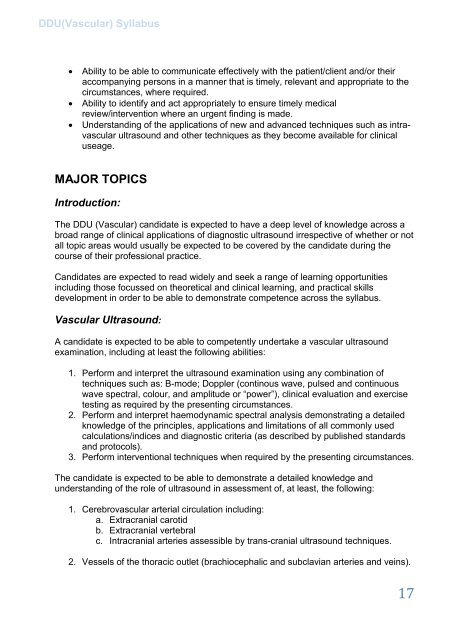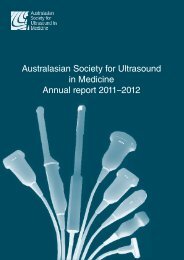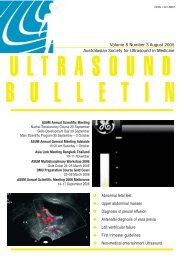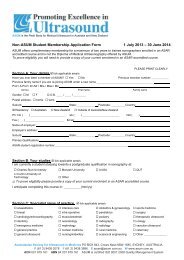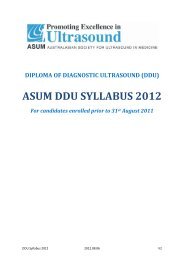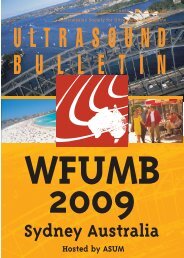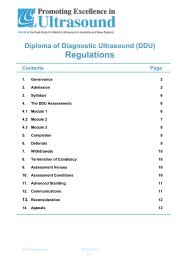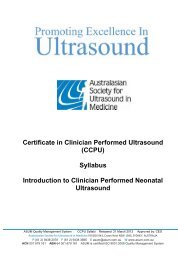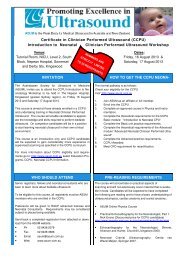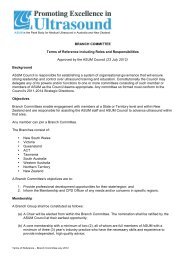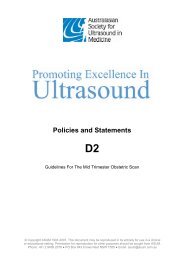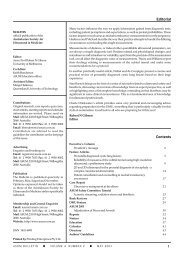DDU(Vascular) - Australasian Society for Ultrasound in Medicine
DDU(Vascular) - Australasian Society for Ultrasound in Medicine
DDU(Vascular) - Australasian Society for Ultrasound in Medicine
- No tags were found...
Create successful ePaper yourself
Turn your PDF publications into a flip-book with our unique Google optimized e-Paper software.
<strong>DDU</strong>(<strong>Vascular</strong>) Syllabus• Ability to be able to communicate effectively with the patient/client and/or theiraccompany<strong>in</strong>g persons <strong>in</strong> a manner that is timely, relevant and appropriate to thecircumstances, where required.• Ability to identify and act appropriately to ensure timely medicalreview/<strong>in</strong>tervention where an urgent f<strong>in</strong>d<strong>in</strong>g is made.• Understand<strong>in</strong>g of the applications of new and advanced techniques such as <strong>in</strong>travascularultrasound and other techniques as they become available <strong>for</strong> cl<strong>in</strong>icaluseage.MAJOR TOPICSIntroduction:The <strong>DDU</strong> (<strong>Vascular</strong>) candidate is expected to have a deep level of knowledge across abroad range of cl<strong>in</strong>ical applications of diagnostic ultrasound irrespective of whether or notall topic areas would usually be expected to be covered by the candidate dur<strong>in</strong>g thecourse of their professional practice.Candidates are expected to read widely and seek a range of learn<strong>in</strong>g opportunities<strong>in</strong>clud<strong>in</strong>g those focussed on theoretical and cl<strong>in</strong>ical learn<strong>in</strong>g, and practical skillsdevelopment <strong>in</strong> order to be able to demonstrate competence across the syllabus.<strong>Vascular</strong> <strong>Ultrasound</strong>:A candidate is expected to be able to competently undertake a vascular ultrasoundexam<strong>in</strong>ation, <strong>in</strong>clud<strong>in</strong>g at least the follow<strong>in</strong>g abilities:1. Per<strong>for</strong>m and <strong>in</strong>terpret the ultrasound exam<strong>in</strong>ation us<strong>in</strong>g any comb<strong>in</strong>ation oftechniques such as: B-mode; Doppler (cont<strong>in</strong>ous wave, pulsed and cont<strong>in</strong>uouswave spectral, colour, and amplitude or “power”), cl<strong>in</strong>ical evaluation and exercisetest<strong>in</strong>g as required by the present<strong>in</strong>g circumstances.2. Per<strong>for</strong>m and <strong>in</strong>terpret haemodynamic spectral analysis demonstrat<strong>in</strong>g a detailedknowledge of the pr<strong>in</strong>ciples, applications and limitations of all commonly usedcalculations/<strong>in</strong>dices and diagnostic criteria (as described by published standardsand protocols).3. Per<strong>for</strong>m <strong>in</strong>terventional techniques when required by the present<strong>in</strong>g circumstances.The candidate is expected to be able to demonstrate a detailed knowledge andunderstand<strong>in</strong>g of the role of ultrasound <strong>in</strong> assessment of, at least, the follow<strong>in</strong>g:1. Cerebrovascular arterial circulation <strong>in</strong>clud<strong>in</strong>g:a. Extracranial carotidb. Extracranial vertebralc. Intracranial arteries assessible by trans-cranial ultrasound techniques.2. Vessels of the thoracic outlet (brachiocephalic and subclavian arteries and ve<strong>in</strong>s).17


